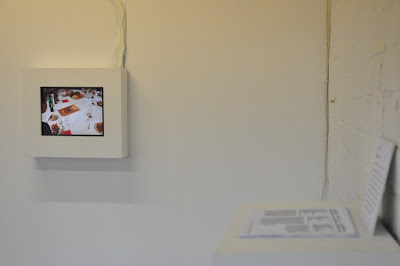Post – Industrial Revolution project is nearing completion. The artists left Gdansk on Sunday. Kate and I are back in Birmingham too. It was hard to leave the shipyard, an area where nature meets culture, where our artists were producing new art works for a month. Thirty-degree heat did not help to install the exhibition, but strongly encouraged our evening trips to the beach and sipping cocktails in one of the old town's cafes . We found time for both though. After a few days of installing we were ready to discuss artists' works during Thursday's talk, and to finally show their final products during Friday's opening. Aliceson Carter and Matthew de Kersaint Giraudeau shown their works at Modelarnia, Louie + Jesse at the Kiosk. Both spaces are part of Wyspa Progress Foundation. The opening gathered a nice bunch of people, which later transferred to Buffet, Wyspa's club. Currently artists and curators are gone but the exhibition is open until Sunday the 12 of June, from Thursday till Sunday (11:00 - 18:00), at two locations - Modelarnia and Kiosk.
Alicson Carter, performance with Zbigniew Stefanski, Modelarnia, 2011
Alicson Carter, performance with Zbigniew Stefanski, Modelarnia, 2011
Alicson Carter, performance with Zbigniew Stefanski, Modelarnia, 2011
For the Post - Industrial Revolution Aliceson has developed a performative video piece paying homage to the Gdansk Shipyard. By acquiring a boat, recording her journey, while playing shipyard songs, Aliceson has created a floating monument to the shipyard. With this piece Aliceson attempts to celebrate current and past production within the Gdansk shipyard as well as its origins as the birth place of the Solidarity movement. ‘My boat making and broadcasting of solidarity songs would be a homage, as an outsider, to the people & history of the shipyard’ – says Aliceson. The boat, now situated in Modelarnia accompanies a projection of the filmed voyage. During the opening night Aliceson in collaboration with Zbigniew Stefanski (Shipyard’s bard) recited shipyard songs with a twist. Aliceson sang a new song she has written about the shipyard and regeneration plans for the Young city development plan to the tune of Shipbuilding by Elvis Costello/Robert Wyatt.
Matthew de Kersaint Giraudeau, installation, Modelarnia, 2011
Matthew de Kersaint Giraudeau, installation, Modelarnia, 2011
Matthew had developed an installation involving moving image, sound recordings and found materials from in and around the shipyard collected during his wanderings. Matthew describes Post-industrial landscapes as haunting - full of economic, political and ideological histories. During his time in the shipyard he attempts to uncover these histories and connect them with a wider network of contemporary ideas. The installation takes the form of two video works and three audio pieces. The audio works within this exhibition consist of headphones set within pile of debris (sand/dirt/rubble and other found objects). Each audio piece is an interview with individuals Matt has met during his time in Gdansk, drawing on issues which have caught his interest such as the young city development, as well as stories from Wyspa Sobieszewska, the island on which Matthew was staying during the residency period.
Louie + Jesse, If we stop now, they will crush us like bed bugs, audiovisual installation, Kiosk, 2011
Louie + Jesse, If we stop now, they will crush us like bed bugs, audiovisual installation, Kiosk, 2011
Louie + Jesse have created a site-specific installation exploring the shipyard strike of 1970 and 1980. They are interested in the so called selective cleansing of history, how some areas are left as monuments and others (the messy elements) are demolished. They are interested in exploring the role of Alina Pienkowska in Shipyard’s strikes, an activist and nurse who became stranded in the clinic during the strike activity. They researched a particular moment within the strike’s history, just before communication lines were cut off. A moment where Alina made a quick but vital phone call to Jacek Kuroń stating details of the strike including its demands. As a result information about the strike was relayed worldwide. It is an understated but significant moment within the shipyards history. Having acquired a kiosk space just outside Wyspa Institute of Art as a location in which to realize their artwork, Louie and Jesse have developed a site-specific installation. The installation appears to be a cross between a hospital room and a hotel room. Their work draws on archival material about Alina but is also influenced by the recent young city developments and regeneration taking place within the shipyard grounds.














































